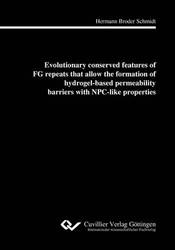| Fachbereiche | |
|---|---|
| Buchreihen (96) |
1379
|
| Nachhaltigkeit |
3
|
| Gesundheitswesen |
1
|
| Geisteswissenschaften |
2367
|
| Naturwissenschaften |
5407
|
| Mathematik | 229 |
| Informatik | 319 |
| Physik | 980 |
| Chemie | 1364 |
| Geowissenschaften | 131 |
| Humanmedizin | 243 |
| Zahn-, Mund- und Kieferheilkunde | 10 |
| Veterinärmedizin | 108 |
| Pharmazie | 147 |
| Biologie | 835 |
| Biochemie, Molekularbiologie, Gentechnologie | 121 |
| Biophysik | 25 |
| Ernährungs- und Haushaltswissenschaften | 45 |
| Land- und Agrarwissenschaften | 1004 |
| Forstwissenschaften | 201 |
| Gartenbauwissenschaft | 20 |
| Umweltforschung, Ökologie und Landespflege | 148 |
| Ingenieurwissenschaften |
1793
|
| Allgemein |
98
|
|
Leitlinien Unfallchirurgie
5. Auflage bestellen |
|
Erweiterte Suche
Evolutionary conserved features of FG repeats that allow the formation of hydrogel-based perme-ability barriers with NPC-like properties
Hermann Broder Schmidt (Autor)Vorschau
Leseprobe, PDF (460 KB)
Inhaltsverzeichnis, PDF (110 KB)
Non-globular FG domains constitute the permeability barrier of nuclear pore complexes (NPCs), which control all macromolecular exchange between nucleus and cytoplasm. Whilst objects smaller than 30kDa can passively diffuse across this barrier, larger molecules need to be chaperoned by nuclear transport receptors (NTRs). However, the modus operandi and, inextricably linked, the exact physical nature of the NPC permeability barrier are still controversially discussed. Whereas so far, most studies exclusively focused on yeast or vertebrate FG domains, the ability of FG domains from different species to form selective barriers was explored here. Interestingly, all studied species contain ‘cohesive’ FG domains that interact with each other to form a characteristic (hydrogel) phase mimicking the permeability properties of NPCs.
| ISBN-13 (Printausgabe) | 9783954044917 |
| Buchendformat | A5 |
| Sprache | Englisch |
| Seitenanzahl | 172 |
| Umschlagkaschierung | matt |
| Auflage | 1. Aufl. |
| Erscheinungsort | Göttingen |
| Promotionsort | Göttingen |
| Erscheinungsdatum | 23.08.2013 |
| Allgemeine Einordnung | Dissertation |
| Fachbereiche |
Biochemie, Molekularbiologie, Gentechnologie
|
| Schlagwörter | Nuclear pore, nuclear transport, FG repeats, permeability barrier, hydrogels |








